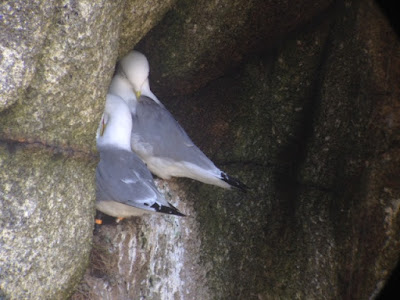This morning a couple of us took to the opportunity for a paddle out to check out the Kittiwakes at Trewavas Head. Leaving from Porthleven, the swellier-than-predicted swell made things a little slow going and we were also unable to safely put the kayak in at the engine houses, so had to make do with a visit to just the main headland colony.
With only around 60 birds there at any time, numbers were down on previous years, but the to-ing and fro-ing of birds mean that we were able to record 19 colour-ringed birds as part of our RAS (Retrapping Adults for Survival) project. The 19 included 17 of our own birds and two French birds that are now
regular breeders here. One of 'our' birds was originally ringed as a
chick on Gugh, Isles of Scilly, in 1996, having a colour ring added by
us in 2015. So at 22 years old this is our oldest bird in the project.

The pic above shows two of the other more interesting birds. AP is a bird we ringed as an adult at Rinsey Cliffs in 2012, remaining there until 2014 when the colony there effectively collapsed. It was one of the few birds that relocated to Trewavas Head, seen just once in 2016 and 2017. The rather more colourful bird was ringed as a chick in 2007 at Pointe du Raz, Brittany, France. It was seen in France in 2009 and 2010, then at Rinsey in 2012 and 2013, before moving to Trewavas Head from 2015 onwards.
Of the other birds, two had also been seen on their coastal wanderings, with one photographed at sea off Longstones Lighthouse in July 2014 and another seen at Gwennap Head in August 2017.






